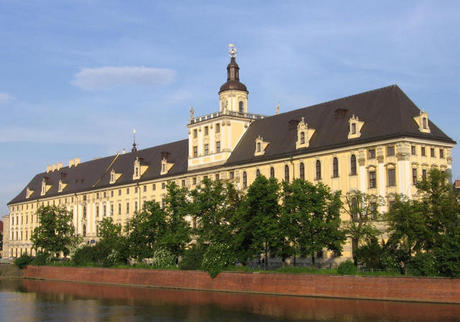University of Wrocław
The University of Wrocław is one of nine universities in Wrocław, Poland. The university was founded in 1702 as Leopoldina, and re-founded in 1811 as Schlesische Friedrich-Wilhelms-Universität zu Breslau. In 1945, after the area passed to Poland, it was re-established primarily by academics from the former University of Lwów. From 1952 to 1989, it was officially named in honour of Bolesław Bierut, and so known as Uniwersytet Wrocławski im. Bolesława Bieruta.
At the request of the town council King Vladislaus II of Bohemia and Hungary signed the foundation deed on July 20, 1505. Due to numerous wars and fierce opposition from near Cracow Academy, however, the new academic institution wasn't built.
The predecessor facilities, which existed since 1638, were converted into Jesuit school, and finally, upon instigation of the Jesuits and with the support of the Silesian Oberamtsrat (Second Secretary) Johannes Adrian von Plencken, donated as a university in 1702 by Emperor Leopold I as a School of Philosophy and Catholic Theology with the designated name Leopoldina. On 15 November 1702, the university opened. Johannes Adrian von Plencken also became chancellor of the University. As a Catholic institute in Protestant Breslau the new university was a important instrument of the Counter-Reformation in Silesia. After Silesia passed to Prussia the university lost its ideological character but remained a religious institution for the education of Catholic clergy in Prussia.
The University of Wrocław has a rich history of more than three centuries. Founded by Leopold I Habsburg the university evolved from a modest school run by Jesuits into one of the biggest academic institutions in Poland. At the beginning of the 19th century the university had five Faculties: philosophy, catholic theology, evangelical theology, law and medicine. Later it was expanded by numerous sections, laboratories and a natural museum, which exists until today.
After the Second World War a group of Polish professors, formerly from Lvov, started teaching and research activities at the University of Wrocław. Initially they created the Faculties of law and administration, arts, natural sciences, agriculture, veterinary, medicine, mathematics, physics and chemistry. Some of these Faculties were soon transformed into other universities
Founded by the Jesuits in 1670, the magnificent Baroque main building of Wrocław University and the adjacent Church of the Blessed Name of Jesus that stand today were built at the same time on the former site of a derelict Piast castle after a land grant from Emperor Leopold. In 1811, Prussia secularised all church property and took over administration of the university. Prior to this the Austrian-Prussian war in 1741 saw the campus transformed into a hospital, a prison and finally, in 1757, a food store. The dying days of WWII saw the university library turned into a makeshift HQ for the occupying Nazis. At the war's end the German faculty were all but exiled, with the replacement professors arriving from the University of Lwów forming the first Polish faculty to teach here. The University still functions as an academic building, and past professors include Alois Alzheimer (the man who gave his name to the disease) and Robert Bunsen (who didn’t invent the Bunsen burner but improved it to such a degree that it was named in his honour). Since the start of the 20th century, the university has produced a remarkable 9 Nobel Prize winners and today over 40,000 students are enrolled with 9,000 graduating each year.
Despite its ongoing functions as an academic institution, the main university building is open to tourists who troop in and out primarily to take photos of Aula Leopoldina, the grand Baroque ceremonial hall. Two tickets are available: one which allegedly gives access to two university rooms, and another which includes four. We recommend you splash out for all four to avoid any later confusion and consternation. The room including the ticket desk includes an exhibit of historical university items from globes to uniforms, however - similar to later displays - all information is in Polish only and is unlikely to hold much interest to casual visitors. Be aware that the areas accessible to tourists are laid out over four floors and there is no elevator. Named after the Austrian Emperor Leopold who founded the university in 1702, the Aula Leopoldina is a beautiful Baroque Hall on the first floor of the main University building. The English information booklet remarks that "the visitor absorbs the beauty around him, sensing his individual existence as being a particle of the universe". Not sure we would go that far but for four and a half zloty it's worth a butcher's hook! You can also visit the 300 Years Exhibition and Mathemician's Tower in the same building.
The first of the University Museum's two main highlights is undoubtedly Aula Leopoldina. In true Baroque style, the ceremonial hall is a virtual explosion of cherubs and swag. The painting on the ceiling depicts the apotheosis of God's wisdom - reflecting the religious and academic mission of this room and the Jesuits. The portraits ringing the walls depict the founding fathers of the University. Some years ago four of them were stolen and two have yet to be returned. Winding upstairs past the odd exhibition and a line in the floor demarcating the 51st parallel - which runs right through the building - visitors will reach the terrace of the university's 'Mathematical Tower' which affords great photo opportunities and panoramic views of the Old Town and Odra River.




